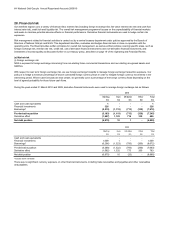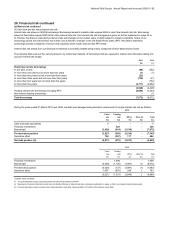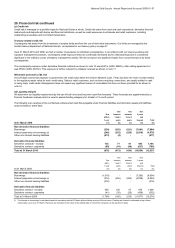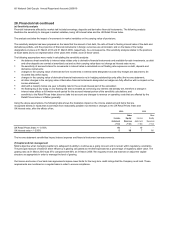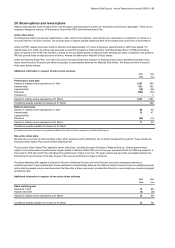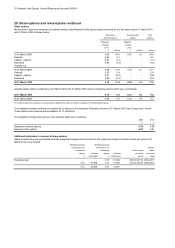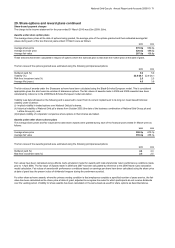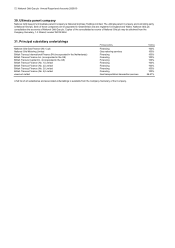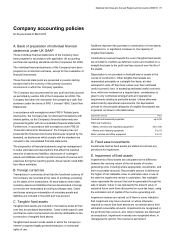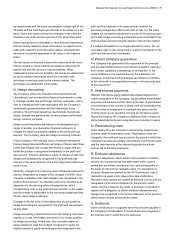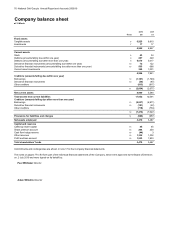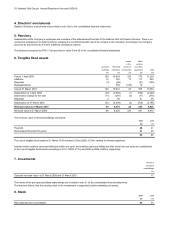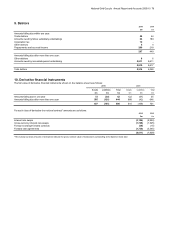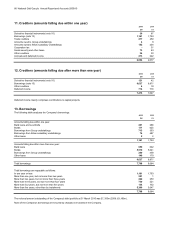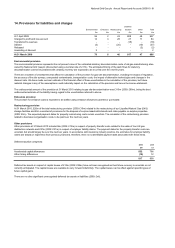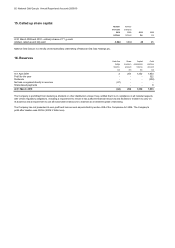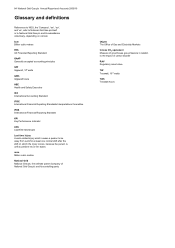National Grid 2010 Annual Report Download - page 76
Download and view the complete annual report
Please find page 76 of the 2010 National Grid annual report below. You can navigate through the pages in the report by either clicking on the pages listed below, or by using the keyword search tool below to find specific information within the annual report.74 National Grid Gas plc Annual Report and Accounts 2009/10
F. Taxation
Current tax for the current and prior periods is provided at the
amount expected to be paid (or recovered) using the tax rates
and tax laws that have been enacted or substantively enacted
by the balance sheet date. Current tax assets and liabilities
arising from transfer pricing adjustments, which are expected to
be fully recovered through group relief, are initially estimated
and recognised in the current year where material. Further
adjustments are recognised when tax returns are submitted to
the tax authorities.
Deferred tax is provided in full on timing differences which result
in an obligation at the balance sheet date to pay more tax, or
the right to pay less tax, at a future date, at tax rates expected
to apply when the timing differences reverse, based on tax
rates and tax laws that have been enacted or substantively
enacted by the balance sheet date. Timing differences arise
from the inclusion of items of income and expenditure in
taxation computations in periods different from those in which
they are included in the financial statements. Deferred tax
assets are recognised to the extent that it is regarded as more
likely than not that they will be recovered. Deferred tax assets
and liabilities are not discounted.
G. Stocks
Stocks are stated at cost less provision for deterioration and
obsolescence.
H. Environmental costs
Environmental costs, based on discounted future estimated
expenditures expected to be incurred, are provided for in full.
The unwinding of the discount is included within the profit and
loss account as a financing charge.
I. Revenue
Revenue represents the sales value derived from the
transmission and distribution of gas and the provision of gas
metering services during the year, including an assessment of
services provided, but not invoiced as at the year end. It
excludes value added tax and intra-group sales.
Where revenue for the year exceeds the maximum amount
permitted by regulatory agreement and adjustments will be
made to future prices to reflect this over-recovery, a liability for
the over-recovery is not recognised as such an adjustment to
future prices relates to the provision of future services. Similarly,
an asset is not recognised where a regulatory agreement
permits adjustments to be made to future prices in respect of an
under-recovery.
J. Replacement expenditure
Replacement expenditure is recognised within operating costs
and represents the cost of planned maintenance of mains and
services assets by replacing or lining sections of pipe. This
expenditure is principally undertaken to repair and maintain the
safety of the network and is written off as incurred. Expenditure
that enhances the performance of mains and services assets is
treated as an addition to tangible fixed assets.
K. Pensions
The substantial majority of the Company’s employees are
members of the defined benefit section of the National Grid UK
Pension Scheme. There is no contractual arrangement or
stated policy for charging the net defined benefit cost of the
scheme to the Company. Accordingly, the Scheme is
recognised in these Company financial statements as if it were
a defined contribution scheme. The pension charge for the year
represents the contributions payable to the Scheme for the
period. A share of the assets and liabilities or the actuarial gains
and losses of the Scheme are not recognised in these
Company financial statements.
L. Leases
Operating lease payments are charged to the profit and loss
account on a straight-line basis over the term of the lease.
M. Financial instruments
Financial assets, liabilities and equity instruments are classified
according to the substance of the contractual arrangements
entered into. An equity instrument is any contract that
evidences a residual interest in the assets of the Company after
deducting all of its liabilities and is recorded at the proceeds
received, net of direct issue costs.
Loans receivable are carried at amortised cost using the
effective interest rate method less any allowance for estimated
impairments. A provision is established for impairments when
there is objective evidence that the Company will not be able to
collect all amounts due under the original terms of the loan.
Interest income, together with losses when the loans are
impaired, is recognised on an effective interest rate basis in the
profit and loss account.
Current asset financial investments are recognised at fair value
plus directly related incremental transaction costs and are
subsequently carried at fair value on the balance sheet.
Changes in the fair value of investments classified as available-
for-sale are recognised directly in equity, until the investment is
disposed of or is determined to be impaired. At this time the
cumulative gain or loss previously recognised in equity is
included in net profit or loss for the period. Investment income
on investments classified as available-for-sale is recognised in
the profit and loss account as it accrues.
Borrowings, which include interest-bearing loans, UK Retail
Prices Index (RPI) linked debt and overdrafts, are recorded at
their initial fair value which normally reflects the proceeds
received, net of direct issue costs less any repayments.
Subsequently these are stated at amortised cost, using the
effective interest rate method. Any difference between proceeds
and the redemption value is recognised over the term of the
borrowing in the profit and loss account using the effective
interest rate method.
Derivative financial instruments are recorded at fair value, and
where the fair value of a derivative is positive, it is carried as a
derivative asset and where negative, as a liability. Assets and
liabilities on different transactions are only netted if the


